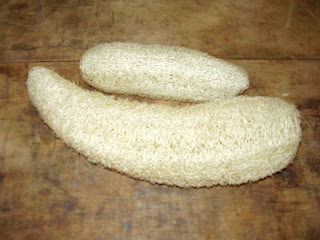Saturday, September 25, 2010
Luffa / Loofah Gourds: The Best Dishscrubbers You Can Grow
I probably won't be loom knitting anymore dishscrubbers, lol, because we have a huge harvest ready of Loofahs. Many folks don't know Luffas are vegetables. You can eat them if you harvest them when they are small (I want to try them for making bread), but if you let them grow on the vine, they will mature into fat vegetable sponges, which you can slice and use to scrub dishes (they work wonderfully on pots and everything else), or to give yourself (or a loved one) a vigorous scrubbing. This could remove all kinds of toxins and impurities that might otherwise stay in your skin! *You can just throw them in your washing machine to get them clean, too.*
Loofahs are wonderfully easy to grow, although they need a strong trellis or support. Mr. Green built that lovely 12' foot trellis this year using 4x4s, a shovel, wooden lattice, and nails and screws. But I have grown loofahs once before on a wooden swing support, or a fence could work fine, too.
Luffahs can be washed right in your washing machine!
The flowers are large and attractive.
When I grew these years ago, I followed instructions I found online that said to leave them on the vine until the sponges and vines turn to brown at the end of the summer. I did this, and it worked. But this year, I read further online, and decided to start harvesting these as they just start to lighten and discolor on the vine. This is much preferable to me because they are much easier to peel when still partially green. I just harvested them and then sat them on a table outside for only a day or two, turning occasionally. Then I whacked them a few times against a step. This loosened the skin, and even cracked it open in places....the sponges are then VERY easy to pull out of the skin, which just peels away. When I did this with already fully dried brown sponges, it would flake away into lots of tiny pieces that had to be scraped off and peeling them took a lot longer.
But this way they are still wet and sappy, so you have to use a strong jet from the hose to wash them out really well, shaking out seeds. Then I put mine back on the table outside to dry a few days, again, turning occasionally. As I said, you can then slice them into about 3" slices (or whatever you prefer) to use in the kitchen, or use a whole sponge for the shower or bath. You can also stuff one into a clean, empty pringle's can and then fill it with melt and pour soap to harden inside. Once the soap has cured, you simply peel away the pringle's container and slice the scrubby soap into bars. I would like to make some of these for Christmas gifts this year again, too.
I snapped a red zinnia, too, in the garden just now. I planted these Scarlet flame Zinnias from seed and now they are nearly 6 feet tall. There is a hummingbird or birds who are loving these; I see them often these days. Zinnias are my favorite flowers, I think, mostly because they grow so well for me. Besides the red, my favorites have been candy cane striped ones this year. I think I planted only 3 different zinnia seed packets and that has been enough for as many bouquets as I would want in my house, as well as enough to continually share bouquets with several neighbors, the teacher, my mom, etc.
I hope you all have a nice day!
Labels:
garden harvest,
gardening,
kitchen gifts,
natural skincare
Subscribe to:
Post Comments (Atom)





5 comments:
I have never heard of these to grow.. wow would love to try them out..... your Zinnia is lovely.....
thanks for sharing Happy Weekend
Hugs Birgit
Very interesting indeed, thank you.
I'm always fascinated by the loofahs and have thought about growing them, but always backed off. I'm going to think harder on it now. I might try next year if I can talk hubby into it.
That is amazing! Oooh I shall look into this for next year; can't believe I was so ignorant about the origin of loofahs.Thanks for the enlightenment :)
That is so interesting! I want one of those!
Olivia
Post a Comment